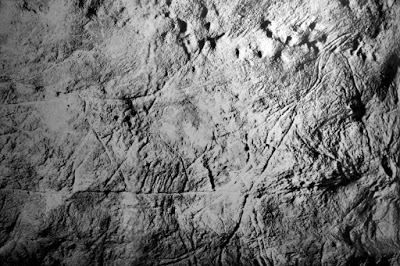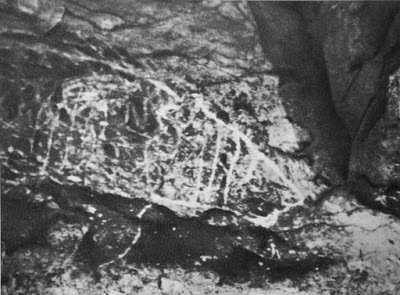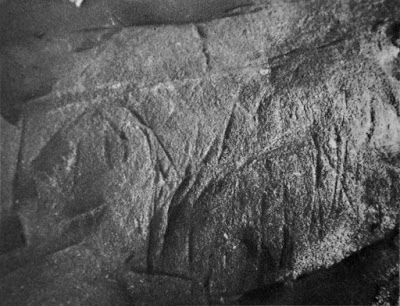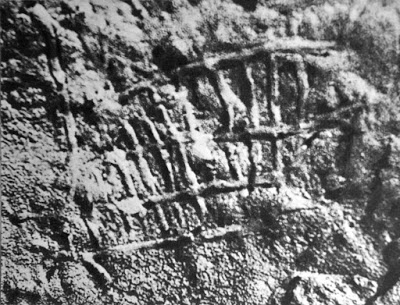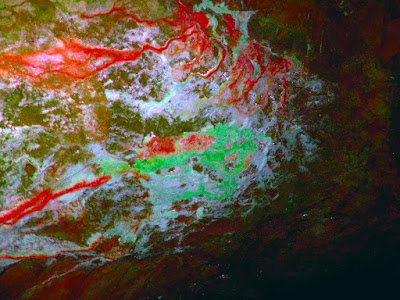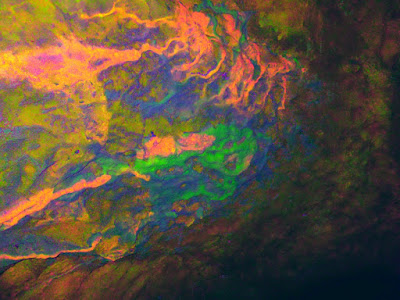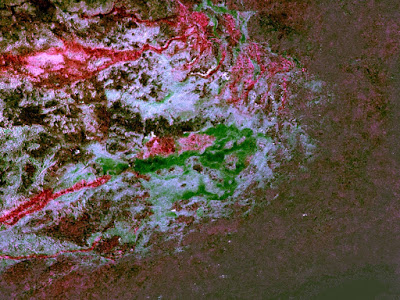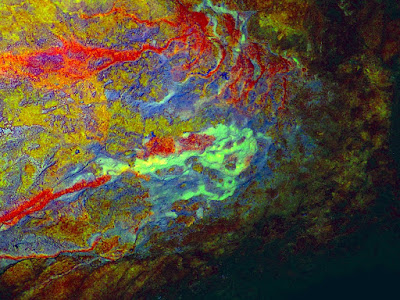.....................................................................................................
Interested in searching? - A few non-expert tips....
1. Before
setting off
Potential
cave art is likely to be difficult to identify on a caves rock surface: It may
be worn by the passage of animals, it may lie beneath layers of modern
graffitti, or it may simply have been eroded by weathering. The keen amateur
therefore needs to be able to know what to look for. The simplest way is to
familiarise yourself with as many photographs of cave art as possible. Then at
least, certain shapes are more likely to stand out. Here are a few suggested
sources to get you started.....
Links:
Cave art, Wikipedia:
https://en.wikipedia.org/wiki/Cave_painting
Cresswell Crags:
http://www.stone-circles.org.uk/stone/creswellcrags.htm
Cresswell Crags:
http://www.antiquity.ac.uk/projgall/bahn300/
Cresswell Crags:
https://www.dur.ac.uk/archaeology/research/projects/all/?mode=project&id=639
Lascauz Cave:
http://www.bradshawfoundation.com/lascaux/
Niaux Cave:
http://www.bradshawfoundation.com/niaux/
Blombos Cave:
http://www.visual-arts-cork.com/prehistoric/blombos-cave-art.htm
Armintxe cave:
http://www.bbc.co.uk/news/world-europe-37654544
Books:
Cave Art
by Paul Bahn (2012):
http://www.bookdepository.com/Cave-Art-Paul-G-Bahn/9780711232570?ref=pd_detail_1_sims_b_p2p_1
Cave Art
by Jean Clottes (2010): https://www.amazon.co.uk/Cave-Art-Jean-Clottes/dp/0714857238
The Caves of France and Northern Spain
by Ann & Gale Seiveking (1962). Plenty of
used copies available for around £5 or £6.
Four Hundred Centuries of Cave Art
by the famous Abbe Breuil (1952). A classic large
format tome, but not cheap...... if you can find a copy. Used copies appear
from time to time from about £50 or £60 upwards. Its 416 pages are packed with illustrations
and photos of engravings and paintings.
Lascaux
by the almost-as-famous Fernand Windels (1950). Another classic large format
publication of 140 pages.
2. Method tips
Choose a cave
: To
examine a cave thoroughly takes time and patience, so select a short cave with
sufficient space to take photos, and with comfortable working conditions. Known
archaeological caves perhaps provide the most potential, although few caves can be
ruled out entirely. The few important archaeological caves are likely to be gated and locked. If choosing such a cave to examine for art, don't be put off: The first point of contact is Cadw. If they grant access, they may send someone to accompany you on your visit, but they should not rule out any genuine applicants.
Engraved art
simply requires a good light source directed obliquely (from several
different angles) in order for variations in the rock to cast the best shadows,
hence making visual identification easier. It's not really practicable to make
a thorough photographic record of a cave for engravings, as the images will
vary enormously depending upon the direction and angle of the light source. A
camera will of course help if any suspect areas are identified. If the sun
shines into a cave at sunrise or sunset, this may also enhance your searching.This was it seems, how the Creswell Crags art was first identified. It takes longer than you might imagine to examine a cave by any method: Each square metre of surface needs to be illuminated from many angles, and patient visual examination can take ages. For this reason, only be accompanied by someone who is as keen as you and intends assisting in the search!
Pigment-based art
may be so faded or eroded that visual
identification with the naked eye is difficult or impossible. There is
however, a method that makes badly faded colours more pronounced and therefore
easier to identify. It is of course, computer software. You first need to
install a host programme, then install the cave art programme as an add-on......
The
host programme is "Image J"
and can be downloaded at:
https://imagej.nih.gov/ij/
The
cave art add-on is developed by John Harman and called "D Stretch" at: http://www.dstretch.com/.
Both
are free to download, although you may need to contact the developer of D
Stretch to explain why you want to use the programme before he'll send it over
as a zip file.
In
order to use this computer method you'll need to take a set of fairly
high-quality digital photos. If checking an entire cave, the images need to be taken systematically along
the entire length of the cave and should include the walls and ceiling. Photos
can be complimented by markers indicating the distance from the entrance and
whether the image is of the left wall or right wall (i.e. "4R"
= the right-hand wall 4 metres from the entrance). Taking the photos can best
be achieved using a camera mounted on a 180 degree swivel-headed tripod
positioned in the centre of a passage. If you have to take more than three
images to capture both walls and ceiling at one camera location,
you may find a wider angle lense helpful. Once a complete photo-record is made,
the results can be examined in detail at home using the software. But it does
take a long time..... and before too long you start imagining cave paintings on the screen in front of you!
(With special thanks to cave archaeologist Dr George Nash for his kindness in suggesting this programme).
Below shows a rock wall with pigment-based art, followed by the D Stretch rendered version highlighting the art.......
Original photo
Courtesy of D Stretch site
CLICK TO ENLARGE
Original photo
Courtesy of D Stretch site
The software offers many different profile options, each enhancing a specific colour. Four examples of the various profiles are shown below, using an image of Dulas Cave (Abergele).
No
cave art as been identified at this cave, but the examples simply demonstrate the potential of the software. The first image is unprocessed. This is then followed by four 'D Stretch' processed photos of the same image............
3. Cave art-hunting equipment
(additional to normal caving gear)
A. LED
site-type flood light
B. LED
hand torch
C. Camera
D. Tripod
with a 180 degree swivel head
E. Tape
measure, pen and paper
F. Computer
and software for pigment identification (not needed in searching for engraved
art)
These are explained below.....
A. An
LED site-type flood light (warm white: between 2400 to 3000 kelvins):
Great
as an all-purpose site light, but its chief advantage is when searching for
pigments: The warmish light brings out the colours far better than the cooler
whites, and helps D-stretch in processing the images later. The minimum output
to look out for when purchasing is about 30w. You can manage with a 20w light, but you may need to increase exposure times in roomy passages, which in turn increases image noise.
B. An LED hand torch (warm white to cool white:
3000 to 4000 kelvins):
Ideal
when searching for engravings. The cooler light offers a more contrasting
'black and white look' which helps in examining shadows. A hand torch is preferable
to a site-type lamp as you'll need to shine the light from many different
angles in order to examine a particular area thoroughly. For this reason, your
camera will need the ability to be triggered remotely, from wherever you are
aiming the torch.
A typical torch is the excellent Xtar flashlight:
https://www.amazon.co.uk/Platoon-Lumens-Tactical-Flashlight-Simple/dp/B00WNVXYXO/ref=sr_1_1?ie=UTF8&qid=1482166958&sr=8-1&keywords=%22xtar+flashlight%22
Even
with a bright torch such as this, you may still need to take longish exposures, but this
does allow you to 'paint' the wall or ceiling with light to give an even spread
of illumination, and thus creates evenly distributed shadows.
C. A
camera capable of producing reasonably high quality images: These days, even
inexpensive compacts can fit the bill. But in order for D-stretch to be most
effective it needs as much digital information as possible. If using a camera with inter-changeable lenses, to keep things simple, choose a lense that provides a field of view sufficient to include both walls and ceiling in just three images. Also allow for a small overlapping area which helps when aligning images later (if you need to join two together to examine the mid-area in more detail).
D. A
Tripod with a 180 degree swivel head (or home-made bracket) makes the whole
operation quicker and helps avoid missing areas or duplicating the areas being
photographed. As a rough guide, if a single passage is say 4m wide by 2m high and 20m long, starting 2m in from the entrance, you should be able to position the tripod at 3m or 4m intervals along the cave for each set of three photos (4m of wall being the field of view of the camera with each image overlapping a little). Hence the completed set should total about 15 photographs (taken from five tripod locations).
E. Tape measure, pen and paper: The tape measure can be used to measure the distance from the
entrance of each tripod location for each set of three images
(left wall, ceiling & right wall). Mark a piece of paper for example '1L' (1m from entrance, left wall) and
place this on the floor just within the cameras field of view. (no need to mark
ceiling photos as they will be between left wall and right wall images). You
can of course, not bother with markers if confident that you will take
your series of photos in reliable order as you advance along the cave, moving
the camera at a uniform distance each time. But in practice, you may find that
for many reasons, you take several shots of the same area, and it can become
rather too easy to mistake the order of photos and invalidate your record, particularly if you actually discover something and need to pin-point its position within the cave.
F. Computer
and software for pigment identification (not needed in searching for engraved
art).

